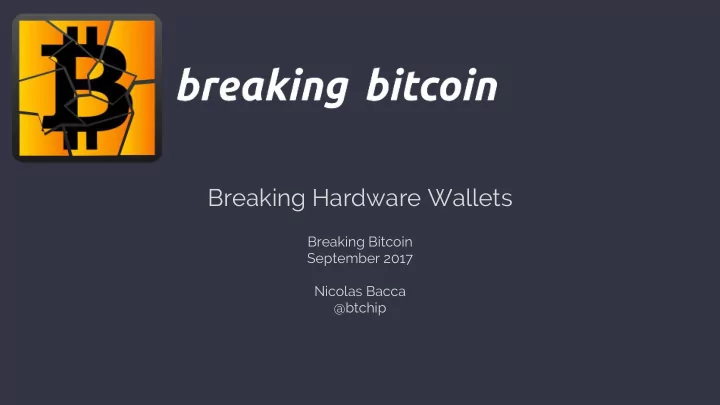

Breaking Hardware Wallets Breaking Bitcoin September 2017 Nicolas Bacca @btchip
Why Hardware Wallets ? - high level overview YES NO Do you want to send 1.337 BTC to Public data 1UnREADABLE Operations on private data, with user validation and proof of user presence
Hardware Wallets - what is needed Protection against malware Protection of the private keys, the most critical asset Validation of the operation being performed, in a trusted environment Protection against physical theft Protection against bad cryptography Trustworthy RNG Side channel resistant implementations
How to break hardware ? Hack attack : software Shack attack : low-budget hardware attack Lab attack : “unlimited” time, resources (From ARM Trustzone security guidelines : http://infocenter.arm.com/help/index.jsp?topic=/com.arm.doc.prd29-genc-009492c/ch 01s03s03.html)
Software attacks For generic programming error to buffer overflows, the usual things - nothing hardware specific Repository of timely fixed TREZOR issues at https://github.com/btchip/trezor-security-exploits
Shack attacks Obtaining information through observable leaks (timing / power) : SPA / DPA Non invasive, non detectable Chip can help to make things less observable, but implementation plays a major role (libsecp256k1, ctaes from Bitcoin Core help) Fault injection Invasive, hard to avoid, unless hardware helps - but not a “magic code change” Clock/Vcc glitching Bus/Memory modifications (more costly)
Lab attacks Chip decapping Microscope analysis Device cannot defend against such attackers supposing no constraints on time
#TLDR Protection Profile Hardware Wallet should not leak secrets on the go with a non too intrusive attack An attacker that did her homework should not be able to run a SPA / glitching attack in a shop Hardware Wallets should take some time to leak secrets when “borrowed”, preferably only using a highly intrusive method Value of acceptable time may vary, at least 1 day ?
Hardware wallet chain of trust verifies verifies Bootloader Firmware reflashes reflashes Application Security vs convenience : keeping the user information while updating
Threat levels re. patchability DEFCON 3 Shack attack exploiting the chip DEFCON 2 Shack attack exploiting the firmware DEFCON 1 Software attack
Architecture : single generic MCU Generic Buttons Screen MCU Bitlox, KeepKey, TREZOR Pros Auditability (up to the chip proprietary security mechanisms) Cons No proof of origin Shack attacks : highly vulnerable
Architecture : generic MCU + dedicated crypto chip Generic Buttons Screen MCU Key holder + crypto chip Digital Bitbox, OpenDime Pros Better protection of assets than a Generic MCU Cons No proof of origin / Exotic architecture (business / secret split) Shack attacks : not enough data to conclude
Architecture : Secure Element Generic Buttons MCU Screen (proxy) Secure Element (business CoolWallet, Feitian, Ledger logic) Pros Proof of origin Cons Limited auditability Shack attacks : strongly protected against
Architecture : secure MCU Secure Buttons Screen MCU Secalot Pros Auditability (up to the chip proprietary security mechanisms) Cons No proof of origin Shack attacks : not enough data to conclude
Forgot anything ? Impersonating the hardware is easy
Typical evil hardware wallet Buttons Evil MCU Screen The Real Thing Hard to protect against without visual inspection and/or building the device yourself Traceability helps, to a given extent
Forgot anything ? take 2 Attacking from the UX angle is even easier
Payment Address SNAFU During a regular payment process, a newly generated address is used If not checked using a second channel, no way to trust it - hardware wallets don’t help much in this situation Payment requests (BIP 70) offering an end to end validation of the address are not popular
Confusing forks Latest example : Bitcoin Cash Same address format Anti-replay with a different signature algorithm, but too late if receiving Malicious service risks when interacting with the device Obtain information about the other chain Sign on the other chain Avoidable by extremely clear UX and limiting impact with tricks (such as locking to a specific HD derivation path)
Change account ransomware Derive private key on path 44’/0’/0’/0 (BIP 32) Send Change to 44’/0’/0’/1/entropy Change looks fine. It really belongs to you, no problem here, I checked it Ok, seems legit Hey I got some entropy to sell you
Hardware wallets on existing hardware Attractive proposal : no additional hardware to buy Achieved with modern CPUs featuring an isolation mode (Intel SGX, ARM TrustZone) Same old issues issues Cryptographic algorithms can be vulnerable to passive attacks Little resistance against physical attacks (other than the complexity of the CPU) And also new ones
Innovative virtualized hardware wallet issues Trusted display & I/O is often available as an optional feature Different trust model, with two main options Use attestation features constantly to “enhance” the security of the blockchain with trusted features (POET, Coco, …) Use attestation features optionally to let the owner verify the integrity of the platform, then go back to a trustless model
Introducing BOLOS enclave on Intel SGX Open Source isolation model Moxie virtual CPU (well integrated with GNU toolchain) libsecp256k1 for ECC cryptography ctaes for AES encryption Optional Intel attestation used to check the platform integrity Platform code can be validated and recompiled by the user Wallet code can be validated and modified by the user Bounty at https://github.com/LedgerHQ/bolos-enclave-catchme (delayed a bit, because CVE-2017-5691 ...)
Thank you, now go break some hardware (hint : check your swag bag) @btchip
Recommend
More recommend